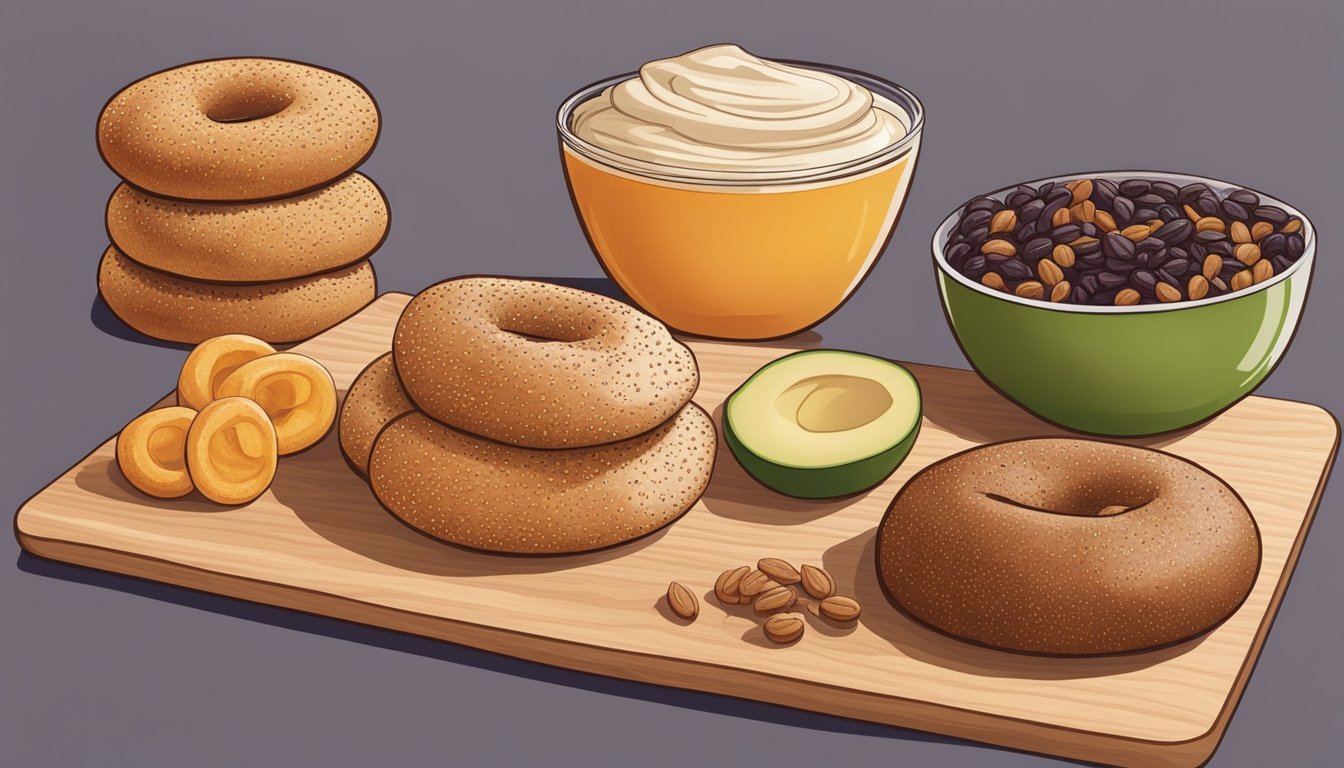Bagel Substitutes
Top Alternatives for a Healthier Breakfast
Bagels have long been a staple for breakfast and lunch, revered for their dense, chewy texture and the satisfying crunch of a toasted crust. Notwithstanding their popularity, dietary restrictions and personal health goals lead people to explore alternative options. With an increasing demand for variety and dietary inclusivity, the quest for bagel substitutes has expanded, aiming to satisfy the palate without compromising on taste or texture.
Alternatives to the traditional bagel encompass a broad range of options, catering to preferences and requirements like gluten intolerance, calorie-conscious diets, and vegan lifestyles. From whole grain tortillas providing a lower-calorie option to the richness of smashed avocado as a stand-in for cream cheese, these substitutes promise to infuse diversity into the breakfast scene. They retain the heartiness of a classic bagel while offering a new spectrum of flavors and nutritional benefits.
For those looking for a change from the routine or seeking new culinary experiences, exploring bagel alternatives can open up a world of possibilities. Whether the alternative is chosen for health reasons or simply to break the monotony, it can offer an equally delightful and fulfilling meal to start the day or enjoy at lunch time.
Understanding Bagels
Bagels are a staple in many diets, renowned for their unique texture and nutritional benefits. As a versatile food, they can be enjoyed in various forms, from traditional recipes to dietary alternatives suited for different needs.
History and Popularity
The bagel has its origins in the Jewish communities of Poland, with historical records pointing to its existence as early as the 17th century. It quickly became popular for its portability and long shelf-life. Bagel's popularity surged, and now they are an integral part of many cultures' breakfast routines, particularly in North America. They’re celebrated for their dense, chewy texture which sets them apart from other bread products.
Nutritional Profile
Bagels are predominantly made from refined wheat flour, which contributes to their carbohydrate content. They also provide a modest source of protein and are low in fat. However, traditional recipes may not have significant amounts of fiber unless whole-grain flour is used or additional fiber-rich ingredients are incorporated. The nutritional content can vary especially with bagel substitutes that may use different grains or ingredients to cater to dietary needs.
Nutrient Approximate Content in Traditional Bagel Calories 250-300 Protein 9-11g Fiber 1-2g Fat 1.5g
Chewy Texture and Flavor
One of the defining features of a bagel is its chewy texture. Achieved through the process of boiling before baking, the texture is further influenced by the length of the boil. A shorter boil results in a slightly fluffier texture. The crust of the bagel is typically crisp, adding a contrasting bite to the chewiness of the bread. Flavor-wise, bagels tend to have a slightly tangy flavor, a byproduct of the fermentation during the dough's proofing stage. The flavor can vary according to the ingredients, with options ranging from savory everything bagels to sweet cinnamon-raisin varieties.
Bagel Substitutes Overview
Shifting dietary preferences and health considerations have led people to seek out bagel substitutes that align with their nutritional needs or restrictions.
Reasons for Substitution
Individuals often look for bagel substitutes to accommodate dietary restrictions or personal taste preferences. Gluten intolerance or celiac disease may necessitate gluten-free bagel options. Similarly, dietary choices such as veganism or lactose intolerance make finding suitable dairy-free alternatives imperative. Those following low-carb diets, such as keto or paleo, also require substitutes to meet their program's guidelines.
Gluten-Free Options: Gluten-free breads, English muffins
Dairy-Free Choices: Dairy-free English muffins, flatbreads
Low-Carb Alternatives: Lettuce wraps, egg-based 'bagels', cauliflower rounds
Health Considerations
When selecting a bagel substitute, one should consider the nutritional profile to ensure it aligns with a healthier option. This involves evaluating the levels of proteins, fibers, and other nutrients. High-protein and high-fiber substitutes can provide longer satiety, which is beneficial for overall health and weight management.
High-Protein: Include alternatives like whole grain breads high in protein.
High-Fiber: Opt for substitutes such as oat bran or whole wheat English muffins.
Bagel substitutes cater to raising health awareness by providing alternatives that offer improved nutritional benefits without sacrificing taste.
Bread Alternatives
When looking for alternatives to traditional bagels, considering the type of bread can lead to nutritious and flavorful choices. Whether one opts for whole-grain benefits or requires a gluten-free solution, there are suitable options to meet these dietary needs.
English Muffin
An English muffin offers a similar size and convenience as a bagel, with lower calories and often a distinctive texture. Typically toasted, they provide a crispy edge that pairs well with both sweet and savory toppings.
Whole-Wheat Options
Whole-wheat alternatives present a wealth of nutritional benefits, including increased fiber. A whole-wheat bagel is a robust option for those seeking hearty flavors and a denser texture. It satisfies the craving for something substantial while also contributing to a balanced diet.
Gluten-Free Choices
For individuals with gluten sensitivities or celiac disease, gluten-free bagel substitutes are essential. Many bakeries and brands now offer gluten-free alternatives that closely mimic the taste and texture of traditional breads. These options typically use a blend of rice flour, tapioca flour, and xanthan gum to achieve a palatable and satisfying consistency.
Using these substitutes can ensure dietary needs are met without sacrificing the pleasure of enjoying a warm, toasty, and versatile bread option for any meal.
Creating Bagel-Like Experiences
Seeking the satisfaction of a bagel without the bagel itself requires a creative approach to ingredients and cooking methods that closely mimic the distinct qualities of this beloved breakfast staple.
Toppings and Spreads
To recreate the essence of a traditional bagel experience, one should carefully select toppings and spreads that provide a similar taste and texture profile. For instance, cream cheese remains a classic choice, offering a rich and smooth complement to any alternative base. For those seeking variety, spreads can range from hummus and avocado to almond butter and a myriad of jams. Here's a concise list of spread options:
Cream cheese (plain or flavored)
Nut and seed butters (e.g., almond, cashew, sunflower)
Hummus
Avocado or guacamole
Jams and jellies (consider a lower sugar option for a healthier alternative)
Similarly, the toppings themselves can range from classic sesame seeds and poppy seeds to more elaborate combinations like garlic flakes, dried onion, or everything bagel seasoning. These ingredients can be easily pressed into spreads to adhere during the toasting process, mimicking the bagel's classic crust.
Preparation and Baking Tips
When it comes to preparation and baking, alternatives such as ciabatta rolls, English muffins, or whole-grain slices can offer a bagel-like texture and heartiness. For a crispy crust and a warm, soft interior, one can employ an oven, toaster, or even an air fryer. Here are key tips for each method:
Oven: A preheated oven, set to around 350°F (175°C), can provide a uniform bake. Place the alternative directly on the rack for a crisper texture.
Toast: For convenience, a standard toaster will work, but be mindful of the settings to avoid burning thinner substitutes.
Air Fryer: An air fryer set to 350°F (175°C) can give a quick and even crispness. Monitor closely as cook times can be short.
For individuals making bagel alternatives from scratch, the incorporation of baking soda into the boiling process can produce a similar chewiness to that of classic bagels. Adjusting boil times can also influence texture, where shorter times yield a fluffier texture and longer times result in a chewier crust. It’s imperative to follow specific recipes tailored to each substitute to achieve the desired results.
Dairy-Based Substitutes
When seeking alternatives for bagels, dairy products provide a versatile range of toppings and ingredients that enhance the flavor and texture of bagel substitutes.
Cream Cheese Variants
Cream cheese is a staple for bagel lovers, but there are various types that can offer new flavors and textures. Neufchâtel cheese has a similar taste and consistency to traditional cream cheese, but with a lower fat content. It is an excellent alternative for those looking for a lighter option. On the other hand, mascarpone, with its creamy and rich texture, can be used for a more indulgent experience.
Cottage Cheese and Ricotta
Cottage cheese and ricotta are two versatile cheese options. Cottage cheese is lighter in texture and offers a lumpy consistency that works well when seeking contrast with smoother bagel substitutes. Ricotta, with its smooth and slightly sweet profile, serves as a creamy spread that pairs well with both savory and sweet accompaniments.
Greek Yogurt and Sour Cream
Switching out traditional spreads for Greek yogurt or sour cream can add a tangy twist. Greek yogurt is thick and can be used as a high-protein, lower-fat alternative to cream cheese. Sour cream adds moisture and a distinctive tartness, making it suitable for those who prefer a more complex flavor profile on their bagel substitutes.
Vegan and Dairy-Free Alternatives
Vegan and dairy-free alternatives for bagels allow individuals with dietary restrictions to enjoy this classic breakfast item. These substitutes cater to those avoiding animal products or lactose, providing flavorful and nutritious options.
Vegan Cream Cheese
Vegan cream cheese options abound, utilizing ingredients such as soy, nuts, and peeled almonds to create a spreadable and creamy consistency similar to traditional cream cheese. They often incorporate a tangy element like lemon juice to achieve the characteristic flavor.
Popular Options:
Soy-based Cream Cheese: Mimics the smooth texture of regular cream cheese.
Cashew Cream Cheese: Offers a rich and nutty taste, often preferred for its natural ingredients.
Plant-Based Spreads
Bagels benefit from a variety of plant-based spreads, each bringing its own unique flavor profile to the table. Dietary needs and personal preference can guide the choice of spread.
Examples Include:
Margarine: A butter alternative that is free of animal-derived ingredients.
Avocado: Mashed or sliced, avocado provides a creamy texture with beneficial fats.
Peanut Butter: A protein-rich option that contributes a savory note to bagels.
Hummus: Offers a savory Mediterranean twist, packed with flavor and nutrients.
Nutritional Yeast Usage
Nutritional yeast is a deactivated yeast popular among vegans for its cheesy, nutty flavor. It's a versatile product often used as a topping for its taste and nutritional profile, including vitamin B12, protein, and fiber.
Applications:
As a Topping: Sprinkled directly onto bagels for a quick flavor boost.
In Spreads: Integrated into vegan cream cheeses or hummus to enhance their umami quality.
Other Savory Substitutes
When considering savory substitutes for bagels, there are ingredients that offer both rich flavors and satisfying textures. These options can transform traditional breakfast sandwiches (What wine goes well with sandwiches?) or standalone snacks into gratifying meals.
Eggs and Potatoes
For a hearty and savory alternative, one could opt for eggs and potatoes—staples in the breakfast realm. Eggs come in various preparations such as scrambled, poached, or hard-boiled, each delivering a distinct texture and taste to the sandwich. Pairing them with potatoes, which can be roasted with a touch of salt for a crispy outside and fluffy inside, adds an extra layer of comfort to the meal.
Eggs: Scrambled, Poached, Fried, Hard-boiled
Potatoes: Home Fries, Hash Browns, Roasted
Combining these elements with savory dips or spreads enhances the overall flavor. Dips such as herbed goat cheese or a creamy havarti cheese sauce can significantly elevate the dish.
Meats and Cheeses
Transitioning from traditional bagel fillings like lox, one can explore a variety of meats and cheeses to satisfy that savory craving. Options like smoked salmon still pay homage to classic bagel toppings, while alternatives like crispy bacon, pan-seared steak, or thinly sliced ham offer new dimensions of taste and richness.
Meats: Bacon, Steak, Smoked Salmon, Ham
Cheeses: Cheddar, Gouda, Havarti, Goat Cheese
The choice of cheese plays a pivotal role in balancing the flavors. Sharp cheddar brings a depth of taste, while smoked gouda introduces a subtle, woody note. Goat cheese offers a creamy tang, and havarti lends a smooth, buttery texture. When selecting a cheese, one must consider both its taste and its melting qualities to ensure it complements the meat it accompanies.
Sweet Spread Alternatives
When considering bagel toppings, sweet spread alternatives offer a delightful contrast to the more traditional savory options like cream cheese. These alternatives not only enhance the flavor of bagels but also cater to those with a sweet tooth.
Fruit Preserves and Jams
Fruit preserves and jams are classic companions for bagels, providing a burst of fruity sweetness. They come in a wide variety, from strawberry and raspberry to exotic flavors like fig and blackberry.
Strawberry Jam: A favorite for its balance of sweetness and tanginess.
Blueberry Preserves: Rich in flavor, with whole blueberries for texture.
One can spread these toppings liberally or dollop them for a more subtle fruit presence.
Nut Butters and Sweet Spreads
Nut butters offer a creamy, protein-packed alternative. Peanut butter is a popular choice, with its rich flavor and satisfying texture. For a twist of hazelnut and chocolate, one might reach for Nutella. This chocolate-hazelnut spread pairs beautifully with both plain and flavored bagels.
Peanut Butter: Available in smooth or crunchy textures.
Nutella: Best applied in a thick layer for an indulgent treat.
These sweet spreads can be enjoyed alone or mixed with other ingredients such as sliced bananas or a sprinkle of cinnamon.
Innovative Toppings and Seasonings
When exploring bagel substitutes, one can greatly enhance the flavor profile with innovative toppings and seasonings. These additions bring out the best in alternative bread choices by integrating a variety of textures and tastes.
Vegetable and Herb Garnishes
For a fresh and vibrant zest, one may consider topping their bread substitute with a medley of roasted vegetables, such as bell peppers, onions, and zucchinis. These ingredients should be lightly coated in olive oil and seasoned with salt and pepper before roasting to achieve a caramelized flavor. Capers and lemon zest can be sprinkled on top to add a burst of tangy and salty notes, which pairs exquisitely with the savory taste of roasted vegetables.
Seed and Spice Mixes
A popular choice for enhancing bagel substitutes is the everything bagel seasoning. This blend typically contains:
Poppy seeds
Kosher salt
Onion flakes
These simple ingredients unite to create a distinctive and flavorful crust when sprinkled on top of breads. For a custom twist, one might consider adding dried garlic flakes or swapping out sesame seeds with black sesame for a different visual appeal and a slight nutty variation in taste. The objective is to utilize these seeds and spices to give each bite a crunchy texture and a robust flavor profile.
Making Bagel Sandwiches Without Bagels
When the craving for a bagel sandwich strikes but there's no bagel to be found, one can still satisfy their appetite with creative substitutes. These alternatives not only stand in for bagels but can also offer new textures and flavors to traditional sandwich fillings.
Sandwich Filling Inspirations
Classic Cream Cheese and Lox: A timeless duo, cream cheese paired with lox, can be embraced using thinly sliced ciabatta rolls. The ciabatta's soft and airy interior nicely complements the rich cream cheese and salty lox.
Vegan Options: For a plant-based twist, one might opt for a vegan cream cheese alternative topped with crisp, pan-seared strips of tofu or tempeh that mimic bacon's texture. Seasoning with salt and pepper can enhance the flavors, akin to the traditional bagel sandwich.
Protein Rich: A filling option that is heavy on protein can be achieved by using scrambled tofu or a vegan egg substitute like 'Just Egg'. These fillings provide a similar taste and texture experience to scrambled eggs without using animal products.
Eggless Yet Hearty: A sandwich without eggs but still satisfying might include layers of cream cheese, smoked salmon (lox), sliced cucumber, red onions, capers, and fresh herbs like dill. This combination offers a fresh and flavorful alternative to egg-based fillings.
Alternative Wraps and Bases
Whole Wheat Wrap: For those looking for a lighter option, a whole wheat wrap can serve as a stand-in for a bagel. It is flexible and can hold an array of fillings while also providing a whole-grain nutritional bonus.
Ciabatta Roll:
Texture Flavor Pairings Light and fluffy Classic cream cheese, roasted vegetables
The table above highlights the ciabatta roll as an alternative, focusing on its airy texture and capability to pair with various fillings.
Regardless of the chosen substitution, creativity is the key to reinventing the beloved bagel sandwich with different bases and fillings to cater to all tastes and dietary preferences.
Creative Cooking Methods
Innovative adaptations of classic bagel recipes allow for new textures and flavors. Utilizing modern kitchen appliances like air fryers can deliver surprisingly satisfying results, just as alternative baking techniques can open doors to different crusts and crumb structures.
Using an Air Fryer
An air fryer offers a unique method for cooking bagels, providing a crispy exterior without the need for deep frying. They should set the air fryer to 360°F and cook their bagels for about 5 minutes, until they achieve a golden-brown crust. This technique is especially useful for those looking to skip traditional boiling methods or for those wanting a crunchier bite.
Ingredients:
Bagel dough
Flour (for dusting)
Egg whites (for egg wash, optional)
Directions:
Prepare dough: After shaping the dough into bagels, let it rest.
Preheat: Preheat air fryer to 360°F.
Dust: Lightly dust the bagel with flour to prevent sticking.
Egg wash (Optional): Brush the top with beaten egg whites for a shinier finish.
Cook: Place them in the air fryer basket and cook for approximately 5 minutes.
Alternative Baking Techniques
Exploring alternative baking techniques can modify a bagel's texture and crust. For instance, adding steam while baking in an oven can mirror the effects of boiling, trapping moisture and leading to a chewier texture. Home bakers can place a pan of water at the bottom of the oven to create this steamy environment. Other modifications might include altering the composition of the flour or adding ingredients like seeds or grains for a different take on the classic bagel recipe.
Tools:
Oven
Pan for water (to create steam)
Baking sheet
Steps:
Steam: Place a pan of water in the oven to create a steamy environment.
Bake: Arrange bagels on a baking sheet, and bake according to the recipe's instructions, allowing the steam to influence the texture.
Observe: Watch for a well-risen bagel with a crispy crust and a tender interior.
Storing Substitutes
Effective storage of bagel substitutes is essential for maintaining their freshness and flavor. Proper techniques can also contribute to a healthier option by preventing spoilage.
Refrigeration Tips
Bagel substitutes such as ciabatta rolls and pumpernickel bread benefit from refrigeration to extend their shelf life. These items should be stored in the refrigerator in an airtight container or wrapped securely to prevent them from drying out. One must note that refrigeration may alter the texture of bread products, potentially making them denser.
Ciabatta Rolls: Store in a sealable plastic bag, removing as much air as possible.
Pumpernickel Bread: Wrap in foil or cling film before placing in the fridge.
Extending Freshness
To extend the freshness of bagel substitutes, one can implement the following strategies:
Refrigerate immediately after purchase or use.
Slice only what is needed, keeping the rest whole to reduce exposure to air.
If the recipe calls for it, one might store seasoning blends in a tightly sealed jar away from heat and light sources.
Bagel Substitute Method of Storage Expected Shelf Life Ciabatta Rolls Airtight container, refrigerated 2-3 days for optimal freshness Pumpernickel Bread Wrapped in foil, refrigerated Up to a week
By adhering to these storage methods, one can enjoy these substitutes at their best quality for a longer period.
Conclusion
Nutritional Superiority
Substitutes for traditional bagels come with enhanced nutritional content, particularly when considering protein and fiber. The Better Bagel, for instance, boasts 26 grams of protein and 35 grams of fiber, significantly surpassing the average bagel.
Home-made Seasoning Blends
Consumers can replicate the beloved Everything But the Bagel Seasoning with common pantry items such as poppy seeds, sesame seeds, dried garlic, and onion, ensuring control over the ingredient quality and taste.
Low-Calorie Options
For those counting calories, swapping out bagels for a small corn tortilla can reduce intake to only 52 calories. When paired with avocado, this alternative provides heart-healthy fats and a creamy texture reminiscent of cream cheese without the heft.
Greek Yogurt Inclusions
Incorporating Greek yogurt into bagel recipes can produce a more bread-like consistency, offering a good balance of carbs and protein, approximately 175 calories, 34g carbs, and 9g protein per serving.
Alternatives Caloric Content Fat Carbs Protein Greek Yogurt Bagel ~175 calories 0g fat 34g carbs 9g protein Corn Tortilla + Avocado ~74 calories ~2.6g fat Variable Variable The Better Bagel Not Specified Not Given Not Given 26g protein
Diverse Applications
These alternatives are not only healthier but also versatile, suitable for a variety of dishes from avocado toast to salads, making them an ideal choice for individuals seeking to maintain a balanced diet.











